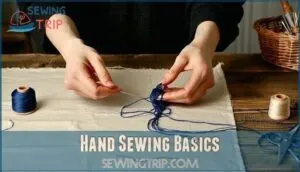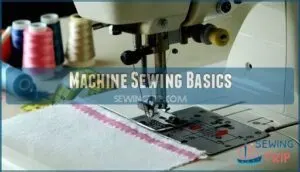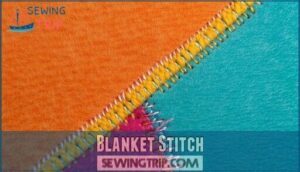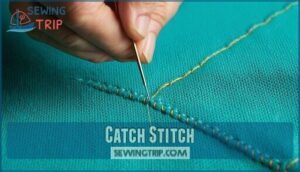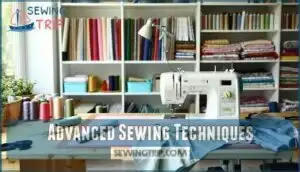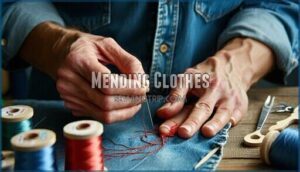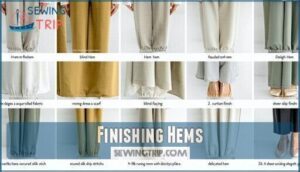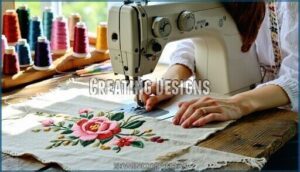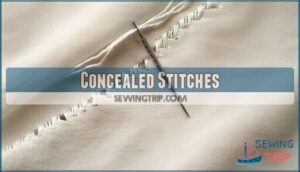This site is supported by our readers. We may earn a commission, at no cost to you, if you purchase through links.
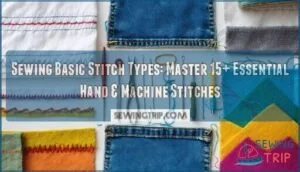 You’ll need these essential sewing basic stitch types to tackle any project confidently.
You’ll need these essential sewing basic stitch types to tackle any project confidently.
Start with the running stitch—your bread and butter for quick seaming.
The backstitch creates strong, permanent connections that won’t budge under pressure.
For stretchy fabrics, zigzag stitches are your best friend, preventing tears and maintaining flexibility.
Master the slip stitch for invisible hems that look professionally finished.
Don’t overlook the blanket stitch for edges or the whip stitch for quick repairs.
Machine stitches like straight and overcast handle most heavy lifting, while hand stitches offer precision control.
Each stitch serves a specific purpose, and knowing when to use which technique separates novice sewers from true craftspeople.
Table Of Contents
Key Takeaways
- Master the core hand stitches first – You’ll need the running stitch for basic seams, the backstitch for durability, the slip stitch for invisible hems, and the blanket stitch for edge finishing to handle most sewing projects confidently.
- Choose machine stitches based on fabric type – Use straight stitches for woven fabrics, zigzag stitches for stretchy materials, and overcast stitches to prevent fraying on raw edges.
- Practice proper technique for professional results – You’ll get better outcomes by maintaining consistent stitch length, adjusting thread tension correctly, and selecting the right needle for your fabric weight.
- Start with basics before advancing – Focus on perfecting fundamental stitches like the running stitch, the backstitch, and the slip stitch before moving to specialty techniques like French tacks or pickstitch for complex tailoring work.
Hand Sewing Basics
You’ll master five essential hand stitches that form the foundation of all sewing projects, from quick repairs to detailed embroidery work.
These fundamental techniques require only a needle, thread, and fabric, making them accessible tools you can use anywhere without machinery, and are essential for all sewing, including quick repairs.
Running Stitch
The running stitch serves as the foundation stone for all hand sewing techniques. This versatile member of basic sewing stitches involves weaving your needle up and down through fabric in even intervals.
Perfect your technique with these essentials:
- Adjust stitch length based on your fabric choice – shorter for delicate materials
- Maintain consistent spacing for professional results
- Use contrasting thread colors for embroidery uses
- Try the Sashiko variation for decorative patterns
- Apply to countless DIY projects
Master this fundamental hand sewing stitch to access advanced sewing stitch types.
Basting Stitch
Basting stitch acts like fabric’s safety net for temporary stitching and fabric preparation. This loose, removable stitch holds pieces together before permanent sewing, making it perfect for quick projects and seam alignment.
For projects requiring easy disassembly, consider using specialized thread options.
Master these basic sewing stitches essentials:
- Use longer stitch lengths (¼ to ½ inch) for easy removal
- Keep thread tension loose to prevent fabric puckering
- Choose contrasting thread colors for better visibility during removal
Backstitch
The backstitch creates rock-solid seams that outlast most hand sewing stitches.
You’ll overlap each stitch by working backward, then forward—this technique makes it perfect for seam reinforcement and durable repairs.
Backstitch variations work well on everything from delicate fabrics to leather stitching. Many resources exist for backstitch leather projects.
Master tension control: too tight puckers fabric, too loose compromises strength. This basic sewing stitch becomes your go-to for decorative backstitch work and reliable hand sewing techniques.
Cross Stitch
Cross stitch creates beautiful X-shaped patterns using simple embroidery stitches on Aida cloth.
You’ll count threads to form intricate designs with various thread types and color palettes.
- Pattern design follows charts for precise placement
- Thread types include cotton floss and specialty fibers
- Framing options showcase your finished cross stitch artwork
This hand sewing technique transforms basic stitches into decorative masterpieces.
Slip Stitch
The slip stitch creates invisible hems and seamlessly closes openings in your sewing projects.
Also known as the ladder stitch, this hand sewing technique hides completely when done correctly.
You’ll slide your needle through fabric folds, catching just a few threads with each pass.
Perfect for closing seams on pillows or hemming garments, this versatile stitch works across various fabric types.
Choose matching thread choice for truly invisible results in your hand sewing stitches repertoire.
Machine Sewing Basics
Machine sewing transforms your projects with speed and precision that hand stitching can’t match.
You’ll master five essential machine stitches that handle everything from basic seams to professional-looking hems and buttonholes.
Standard Forward/Backward Stitch
Every sewing machine’s standard forward/backward stitch forms the backbone of most projects.
You’ll master seam reinforcement by adjusting stitch length based on fabric weight—shorter for durability, longer for gathering. Tension adjustment guarantees perfect stitches across different materials, while fabric compatibility determines your success.
Here’s why this stitch rocks your sewing basics:
- Creates strong, reliable seams that won’t fail you
- Works on virtually every fabric type you’ll encounter
- Provides excellent industrial applications for heavy-duty projects
- Offers precise control over your stitching speed
- Forms the foundation for mastering other basic stitch types
Zigzag Stitch
The zigzag stitch transforms ordinary sewing into creative artistry.
You’ll discover this versatile machine stitch handles stretch fabrics effortlessly while creating stunning decorative zigzags.
Mastering stitch width and length adjustments reveals endless possibilities for applique techniques and professional seam finishes.
| Stitch Width | Best Use | Needle Types |
|---|---|---|
| 1-2mm | Stretch seams | Ballpoint |
| 3-4mm | Standard edges | Universal |
| 5-6mm | Decorative stitches | Embroidery |
| Variable | Applique techniques | Sharp |
Perfect your zigzag stitch through consistent practice with different sewing stitches and stitch techniques.
Overcast Stitch
The overcast stitch tackles edge finishing like a pro, preventing fabric edges from unraveling with precise diagonal stitches.
This versatile technique wraps thread around raw edges, creating secure seam prevention that outlasts basic finishes.
You’ll find overcast variations perfect for different fabric weights – adjust your machine’s settings accordingly.
Master this fundamental technique in your sewing stitch guide, and you’ll transform messy edges into professional-looking seams.
Essential among hand sewing stitches and machine sewing techniques alike.
Buttonhole Stitch
Master the buttonhole stitch to create professional openings for buttons.
Your machine offers several buttonhole variations including keyhole buttonholes for thick buttons and corded buttonholes for extra strength. Faux buttonholes work perfectly for decorative touches.
Plan your buttonhole spacing carefully—measure twice, stitch once. Many sewers find specialty tools useful for consistent results.
Among all machine stitches, this transforms garments from homemade to handcrafted perfection.
Blind Hem Stitch
Perfection happens when nobody notices your hemming work. The blind hem stitch creates invisible hems that look professionally finished on garments.
Your machine’s specialized presser foot guides fabric while catching only a few threads from the front side. Proper stitch tension prevents puckering and maintains the invisible effect across different fabric types.
- Machine setup: Use the blind hem presser foot and adjust stitch width
- Fabric preparation: Fold hem twice, leaving slight overhang for catching
- Stitch tension: Test on scraps first to avoid visible marks
- Best applications: Pants, skirts, curtains, and formal garment finishing
Essential Hand Stitches
Beyond basic hand stitches, you’ll need three essential techniques that handle specialized sewing tasks with precision and durability.
These stitches—blanket stitch, whip stitch, and catch stitch—provide professional finishing methods for edges, seams, and hems that can’t be achieved with simple running or back stitches, utilizing precision to ensure durability.
Blanket Stitch
The blanket stitch creates secure edge finishing while adding decorative borders to your projects.
You’ll work from left to right, keeping the thread under your needle to form that signature loop.
| Application | Purpose |
|---|---|
| Blanket Edges | Prevents fraying on wool blankets |
| Craft Applications | Adds texture to felt projects |
| Stitch Variations | Customize spacing for different looks |
Perfect for hand sewing stitches and embroidery stitches alike.
Whip Stitch
While the blanket stitch creates beautiful edges, the whipstitch takes a simpler approach to edge joining and seam finishing.
You’ll wrap thread diagonally around fabric edges, making it one of the most straightforward hand sewing stitches available.
This versatile stitch type handles multiple applications:
- Edge joining for connecting fabric pieces
- Seam finishing to prevent fraying
- Decorative whipstitch for visible accents
- Quick hemming projects
- Whipstitch variations for different textures.
Perfect for beginners learning hand sewing.
Catch Stitch
When your hems need flexibility and strength, the catch stitch delivers both beautifully.
This diagonal stitch creates a zigzag pattern underneath fabric, making it perfect for flexible hems on knits and stretchy materials.
Working right to left, you’ll catch just 1-3 threads for invisible stitching results.
Unlike rigid blind hem stitches, this technique accommodates movement while keeping your hand sewing nearly undetectable from the garment’s right side.
Advanced Sewing Techniques
Once you’ve mastered the basic stitches, you’re ready to combine techniques and develop your own variations that suit specific projects.
These advanced methods let you create professional-quality results by adapting fundamental stitches to meet unique fabric needs and design requirements.
Mastering Hand Sewing
Hand sewing mastery starts with proper needle selection and thread types that match your fabric choice.
Keep stitch tension consistent—not too tight, not too loose.
Practice good ergonomics by maintaining comfortable posture and taking breaks.
These hand sewing basics and hand sewing tips transform hand sewing for beginners into confident stitching.
Master these basic stitch types through regular practice and patience.
Creating Personalized Stitches
Your stitch customization journey begins with experimenting beyond basic techniques.
Mix thread choices with different fabric pairings to create stunning decorative stitches that reflect your personal style.
Stitch variations like modified chain stitches or layered running stitches offer endless embellishment options. Try combining contrasting thread weights or colors to develop unique patterns.
These personalized sewing stitches transform ordinary projects into signature pieces. Practice different stitch applications on fabric scraps before committing to your final design.
Sewing Stitch Applications
You’ll use different stitches for specific tasks, from mending torn fabric to creating decorative patterns on your projects.
Each stitch serves a particular purpose, whether you’re finishing hems invisibly, securing seams permanently, or adding embellishments to garments. Each stitch serves a particular purpose.
Mending Clothes
Your favorite shirt doesn’t have to hit the trash can just because of a small tear.
Mending clothes with basic hand sewing techniques can restore garments to their former glory while saving money.
- Running stitch works perfectly for tear repair on lightweight fabrics
- Backstitch provides seam reinforcement for high-stress areas
- Slip stitch handles patch application with nearly invisible results
- Darning technique fixes holes through fabric darning methods
- Whip stitch secures loose seams and prevents further damage
Finishing Hems
Clean edges make all the difference in professional-looking garments.
Blind hem stitch creates invisible finishes, while rolled hems work perfectly on lightweight fabrics.
Master these hemming stitches for polished results every time.
| Hem Type | Best For | Stitch Used |
|---|---|---|
| Blind Hems | Dress pants, skirts | Blind hem stitch |
| Rolled Hems | Scarves, lightweight fabric | Rolled edge technique |
| Hem Facing | Heavy fabrics, curved edges | Slip stitch |
| Weighted Hems | Curtains, drapes | Running stitch |
Creating Designs
Your creative vision comes alive when decorative stitches transform plain fabric into stunning artwork.
Hand sewing opens endless possibilities for stitch patterns and embellishment techniques. Choose fabric selection that complements your color palettes, then experiment with embroidery stitches to develop unique stitch variations.
- Cross Stitch: Creates bold geometric patterns with precise X-shaped formations
- Chain Stitch: Forms flowing curves perfect for floral motifs and borders
- Backstitch: Delivers clean outlines for detailed design inspiration
Concealed Stitches
Beyond decorative work, you’ll master concealed stitches for professional results.
The blind stitch creates invisible hems in garment alterations, while invisible ladder stitch repairs tears seamlessly.
These finishing stitches handle upholstery applications and mending techniques with precision.
| Stitch Type | Best Application |
|---|---|
| Blind Hem | Invisible hems on pants |
| Ladder Stitch | Closing stuffed toys |
| Slip Stitch | Hand sewing repairs |
These tailoring secrets guarantee flawless hemming stitches every time.
Specialty Stitches
You’ll encounter specialty stitches that serve specific purposes beyond basic sewing, from creating flexible connections with French tacks to achieving nearly invisible finishes with pickstitch.
These advanced techniques, including prickstitch, overhand stitch, and chain stitch, expand your sewing capabilities for professional-quality results in tailoring, mending, and decorative work, utilizing techniques like pickstitch.
French Tack
When you need a flexible connection between fabric layers, the French tack delivers perfectly.
This simplified tailors tack creates loose thread loops that allow independent movement while keeping pieces connected.
Unlike traditional fabric marking methods, French tacks function as finishing stitches in garment construction.
They’re essential hand stitches for hems, linings, and armholes where rigid attachment would create pulling or distortion.
Prickstitch
Prickstitch creates an Invisible Prickstitch effect by catching just one or two fabric threads, making it perfect for Tailoring Applications.
This Pickstitch Variation requires careful Fabric Choice and consistent Stitch Length for professional results.
Master this technique with these steps:
- Select appropriate thread weight for your fabric
- Keep backward stitches minimal for invisibility
- Maintain even spacing throughout your work
- Practice on scraps before final application
Pickstitch
While prickstitch goes through all fabric layers, pickstitch catches only a few threads for maximum stitch concealment. This hand sewing technique creates invisible seams by showing tiny stitches on the fabric’s right side with long spaces between them.
Tailoring applications include securing lapels and preventing edge rolling. You’ll find pickstitch variations in both hand and machine methods, though machines show two threads instead of one.
Master this pick stitch for professional finishes on any fabric choice requiring subtle reinforcement.
Overhand Stitch
The overhand stitch transforms fabric edge joining into child’s play.
This vintage hand sewing technique secures two folded edges together, creating professional seam finishing results.
Work right to left, maintaining consistent spacing for ideal fabric securing.
Beyond basic construction, explore decorative uses and overhand variations to elevate your sewing stitches.
Master this fundamental hand stitch for reliable, flexible seams.
Chain Stitch
Chain stitch creates interlocking loops that form bold chain patterns perfect for decorative chain stitch work.
This ancient embroidery stitch offers incredible chain stitch variations for hand sewing projects.
Chain stitch embroidery excels at outlining designs and filling spaces.
Chain stitch uses include hemming jeans and creating textured borders.
Master this versatile decorative stitch for stunning results.
Frequently Asked Questions (FAQs)
What are the different types of sewing stitches?
Think of stitches as your sewing toolkit’s building blocks.
You’ll master running, backstitch, and blanket stitches for basics, plus decorative cross-stitch and chain stitch.
Machine options include straight, zigzag, and buttonhole stitches for different projects.
What are the 7 basic sewing stitches?
You’ll master these seven fundamental stitches: running stitch for basic seams, backstitch for durability, basting for temporary holds, blanket stitch for edges, slip stitch for invisible hems, overcast for preventing fraying, and cross stitch for decoration.
What sewing stitches do you need to know?
Building your sewing toolkit starts with mastering essential stitches.
You’ll need running stitch for basic seams, backstitch for strength, slip stitch for invisible hems, and zigzag stitch for stretchy fabrics and edge finishing.
What stitches should I use if I’m New to sewing?
Start with running stitch for basic seams and basting for temporary holds.
Learn backstitch for strong repairs and slip stitch for invisible hems.
These four foundational stitches will handle most beginner projects effectively.
How many types of stitches are there?
Sewing includes dozens of stitch types across hand and machine techniques.
You’ll find basic stitches like running and backstitch, decorative options like cross-stitch and chain stitch, plus specialized machine stitches for different fabric needs.
What stitches are used in hand sewing?
Hand sewing relies on several fundamental stitches you’ll use regularly.
Running stitch joins fabric pieces, backstitch creates strong seams, blanket stitch finishes edges, and slip stitch provides nearly invisible hems for professional-looking results, including strong seams and nearly invisible hems.
What are the 10 basic stitches?
Over 85% of hand sewers master these ten fundamental stitches first: running, backstitch, blanket, cross, chain, slip, overcast, buttonhole, basting, and French knot.
You’ll use these versatile techniques for repairs, hems, decorations, and professional-quality garment construction throughout your sewing journey.
What are the 7 types of stitches?
You’ll master seven essential stitch categories: running stitches for basic seams, backstitches for strength, decorative stitches like cross-stitch.
Finishing stitches such as overcast, invisible stitches including slip stitch, buttonhole stitches, and specialized embroidery techniques.
What are the basic 5 stitches?
Ready to master the fundamentals?
You’ll need these five essential stitches: running stitch for basic seaming, backstitch for strength, blanket stitch for edges, slip stitch for invisible hems, and cross stitch for decoration.
What stitch is the basic standard for sewing?
The running stitch serves as sewing’s foundation.
You’ll use this simple, straight stitch for most projects, from basic seams to temporary basting.
It’s versatile, beginner-friendly, and essential for building your sewing skills.
Conclusion
Building your sewing foundation is like constructing a house—without mastering these sewing basic stitch types, your projects lack structural integrity.
You’ve now discovered fifteen essential techniques that transform fabric into finished garments, from simple running stitches to complex French tacks, each method serves a specific purpose in your creative arsenal.
Practice these fundamentals regularly, and you’ll develop the muscle memory needed for professional results.
Your journey from beginner to skilled seamstress starts with consistent application of these core skills.

